Cassius Clay TKO6 Henry Cooper, 1966
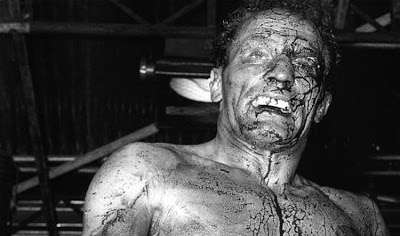
Not unlike Marcel Thil in the first installment of this “bad cuts” list, sitting atop Sir Henry Cooper’s neck was the visage of a born fighter. He looked like a man who had worked in some sort of mine for fun, or picked fights because it just happened to be a day that ended in “y.” Aside from being the definition of a tough customer between the ropes, he also came to be known for his skin’s apparent disinterest in standing up to punishment. In his first loss to Italian Uber Bacilieri in 1955, he was stopped in the 5th round because, as the AP put it, “blood spurted from a cut over the 21-year-old Briton’s right eye.” The following year, another bout against Peter Bates saw him again halted in the 5th round with a badly slashed eyebrow. By the time he hooked up with Muhammad Ali, then Cassius Clay, in 1963, he had seven losses on his ledger, only twice going the distance. Much of the bout is legend, with an already cut up Cooper flooring Clay hard with a left hook at the end of round 4, Clay’s trainer Angelo Dundee loosening a hole in his glove to buy an extra half-minute between rounds to recover, and Clay slicing up Cooper’s face in the 5th to get a stoppage. In 1966, a now heavyweight champion Ali wanted revenge, and made the fact known in usual boisterous style before the first heavyweight title bout held in England in almost 60 years. And this time there would be no huge hook from “Our ‘Enry,” and he would leave the ring with another TKO under his belt, courtesy of cuts over his right eye, the bridge of his nose, and, strangely, his right shoulder. Remarked the AP, via the Oregonian, the initial eyebrow cut looked “as if someone had suddenly knocked over a bottle of very red and warm ketchup on a very white table cloth.”
Rocky Juarez TKO11 Jorge Barrios, 2008
For the most part, Jorge “La Hiena” Barrios was unknown outside of Argentina before his grimy, exciting fight against Acelino Freitas in 2003. But fairly well-known in his home country for wild and even sloppy fights against a number of his countrymen, he’d already been involved in a number of disqualification verdicts, he’d been cut significantly a handful of times, and sent to the canvas his fair share. The Freitas battle served notice to U.S. fans that Barrios was, if nothing else, a fun guy to watch. Trailing over the first half of the fight, Barrios rallied to deck Freitas twice despite leering through a drizzle of blood stemming from both eyes, which he unabashedly wiped off on the referee’s sleeves in the clinch. But in the end, he was TKO’d in the final round. In 2005, he captured one of the belts he failed to snag from Freitas, then lost it to Joan Guzman in 2006. After a series of legal and personal issues, Barrios was set to face Rocky Juarez, who, in his fairly young career, was already on his third comeback from losses. As is and was his calling card, Juarez did far too much following and dipping without throwing through most of the fight, and it was really only Barrios’ own recklessness that kept Juarez in the bout. As Barrios slowed in the later rounds, he became more and more stationary, which in the 11th round allowed Juarez to accelerate his offense. Juarez landed a series of hooks and uppercuts that tore Barrios’ lip half-off, and with less than a minute remaining in the round, Barrios was sent to the canvas. As referee Rafael Ramos administered the count, even he couldn’t keep from cringing at the huge wound, which led to the fight being stopped.
Lennox Lewis TKO6 Vitali Klitschko, 2003
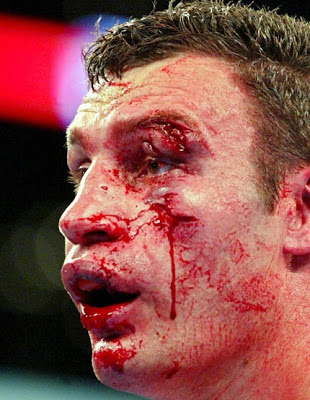
Every so often a fighter manages to rebuild his career with a loss — or at least convince the masses that previous presumptions about his shortcomings were incorrect. The Brothers Klitschko rose through the heavyweight ranks together, each one half of a seemingly more complete machine. But when older brother Vitali suffered his first setback to Chris Byrd, losing his WBO strap in the process, it seemed Byrd exposed a weakness despite trailing on the cards, and many were quick to question Vitali’s toughness and desire. A half-dozen fights later, a June, 2003 Lennox Lewis vs. Kirk Johnson bout was scrapped when the latter tore a bicep muscle in training three weeks out. Rather than waste the date, Vitali was offered the opportunity to step in and challenge for the heavyweight title, which he gladly accepted. Weighing in at a career-highest 256 1/2 lbs., Lewis was caught off guard early on and forced to brawl with Vitali, making for an excellent scrap. But in round 3, Lewis landed a right hand that split open Vitali’s left eyebrow, and between rounds Klitschko’s cutman actually worsened the gore by tearing at the eyebrow with a terry cloth towel. Over the course of the next three rounds, Lewis clawed his way back into the fight and did more damage to his opponent’s face by opening up his left cheek and filleting his upper lip. After the 6th stanza, it became clear that the cuts were too much for Vitali to contend with, and the bout was stopped as he protested and demanded a rematch.
Amir Khan TD5 Marco Antonio Barrera, 2009

Approaching “legend” status for participating in a host of excellent fights, Marco Antonio Barrera wasn’t specifically known as a fighter prone to cutting, unlike many of the names that have graced this list. Through wars against Kennedy McKinney, Erik Morales and even an effort in which he was buzzsawed by Manny Pacquiao, Barrera had received abrasions, swelled eyes and a busted nose, sure, but he had never before been turned into a Mexican Harry Potter. Going into his bout with Amir Khan, the biggest question appeared to be how much the 35-year-old Barrera, then in his 20th year as a professional fighter, had lost on his journey. And it didn’t take long to find out, as Khan began the fight peppering Barrera with hard, quick combinations as Barrera didn’t have an answer for Khan’s speed and youth. In the opening round, however, a head clash opened up cuts on both men, with Barrera clearly sustaining the bulk of the damage. Through almost four more rounds, the “Baby Faced Assassin” was literally covered in blood, and the disadvantages he had from the outside were amplified. Barrera constantly played catch-up, unable to corner his foe and apply pressure when he needed to, and hopelessly out-sped from the outside. In the 5th round, action was stopped to examine the cut, and the bout was halted, leading to a technical decision for Amir Khan.
Jesse James Leija TD5 Micky Ward, 2002

Legendary in his own right, Jesse James Leija became very well-known in the 1990s for his four fights against Ghanaian Hall of Famer Azumah Nelson. A tough but skilled boxer-puncher, Leija had been stopped because of a cut over his right eye was blurring his vision in the third fight against Nelson. In 2002, Leija was coming off a No Contest verdict against Hector Camacho, Jr. that was surprisingly rejuvenating to his career, considering the younger Camacho gave up due to an eyelid wound that appeared to be less-than-mortal after 4 rounds of stopping and stalling. Leija was clearly gaining in momentum, however, despite the fact that he was also cut. The entire situation came off as Camacho, Jr. panicking more than Leija unleashing, but it nonetheless guided Leija to a bout with Micky Ward, who was himself fresh off a great 10 round set-to against Emanuel Burton on ESPN2. Starting slowly, as was basically his trademark, Ward fell behind through 5 rounds and a cut from the 1st round over Leija’s right eye had widened considerably. Likely understanding that Leija had pulled ahead, the decision was made by Leija’s team to cut the action short, effectively putting Leija in a position very similar to Camacho, Jr. in their meeting. Indeed, Jesse James was ahead on two of the three cards and was awarded the technical decision.
Rocky Marciano KO8 Ezzard Charles, 1954
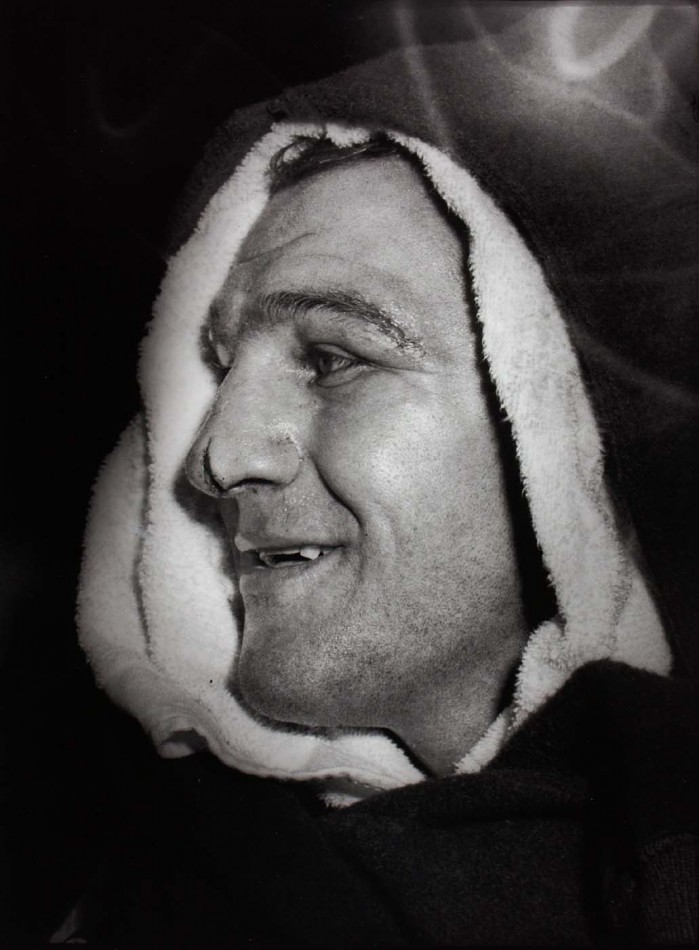
A rough, forceful style tends to mean a shorter career, if not losses spotting a ledger. Rocky Marciano retired undefeated, but his career lasted less than a decade. When Marciano retired, he claimed he’d simply wanted to spend more time with his family, but various rumors circulated through the media that hinted at other issues, such as issues giving up 50% of his money, not wanting to face larger, younger contenders on the upward swing, and years of getting banged around. From hand injuries to various cuts and abrasions, Marciano’s bruising style was injurious to both parties involved. By the time he met up with former heavyweight champion Ezzard Charles, the fragile nature of Rocky’s skin — and his in-ring apathy thereof — was already well-heralded. A hard-fought win by Marciano led to a rematch between the two. In their rematch, a right hand to the ear followed by a series of mauling rights and lefts put Charles down in the 2nd round, and twice more in the 8th Ezz hit the deck, failing to beat the count the second time. The fun part was in the 6th, where a wallop from Charles opened up a deep cut near the tip of Marciano’s nose. Less legendary, but almost equally significant, was the opening over Marciano’s right eye. For weeks after, Marciano would wear a bandage over his sniffer, playfully modeling it for press photos.
Carlos de Leon MD15 Marvin Camel, 1980
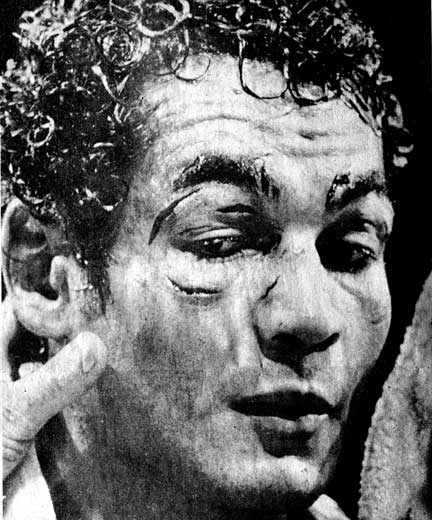
In the days of a fledgling cruiserweight division, titles changed hands often, and many fighters who held them were either unknown, or cared about very little. All fans and pundits seemed to know about cruiserweights was that they weren’t heavyweights. But in turn they missed a number of competitive and sometimes very entertaining, bloody bouts. One such affair was the first match up between Native American cruiserweight Marvin Camel and Puerto Rican Carlos De Leon. Though many reports stated the match up was largely handled by De Leon — a claim bolstered by the condition of Camel’s face after the argument — it was actually more of a back and forth tilt than suggested. Camel managed to sneak in a number of southpaw lefts and snappy jabs in the early rounds, but his facial tissue began to deteriorate from the punches and butts administered by De Leon in the middle rounds. By the end of the bout, De Leon had been penalized a point for a butt, and Camel’s face looked terrible. Said Larry McMillen of the Times-Picayune, “Puerto Rico’s DeLeon opened cuts over both the champion’s eyes and on one cheek early and punched almost at will at the bloody mess that looked nothing like a face after the ninth round. DeLeon… doggedly pursued and pounded the champion who refused to quit though his trunks, white at the onset, were crimson with his own blood at the finish.”
Marvin Hagler TKO3 Alan Minter, 1980
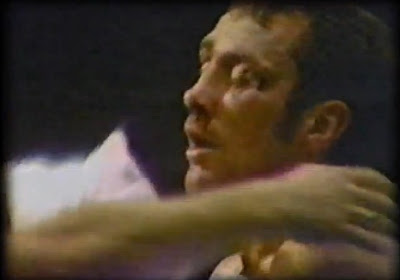
1972 Olympic bronze medalist Alan Minter was a pretty good fighter, but the gauge of his skin was his weakness, as he had been dissected in a dozen or so of his wins and losses. Going into the Hagler bout, 5 of his 6 losses were stoppages due to cuts, and he’d had facial vivisection done on him in wins against Ray Seales, Vito Antuofermo and Renato Garcia, among earlier fights in his career. And unfortunately for him, if Hagler were granted some sort of macabre souvenir belt, he’d have tacked it with broken jaws, bludgeoned foreheads, cut eyebrows and whatever other butchery you could ask for in a boxing ring. Marvin Hagler’s sharp but unyielding style was perfect for splitting flesh, and he carried with him a knapsack overflowing with grit — the result of banging out a solid 49-2-2 ledger against tough, but essentially unheralded opponents. Additionally, Minter had been cut in his middleweight title-winning effort against Antuofermo just over six months earlier. Staying southpaw for most of the bout, Hagler nailed Minter with left hands almost at will against a game Minter, and at the start of the 3rd round, his right cheek had already begun to swell. And in that 3rd round, Hagler opened up with a barrage of leaping right hooks that sent Minter’s mouthpiece on a 10th row vacation, had the Brit rattled, but also bleeding badly from a cut over his left eye. A couple more clubs to the mug sent Minter to his corner to be examined, at which point it was promptly stopped, and likely for the better, as Minter’s right eye was falling apart quickly itself. The event is likely just as well known for the revolt that ensued among the fans at Wembley Arena, who pelted Hagler and his team with beer cans and bottles until they were escorted out.
Oscar De La Hoya TKO4 Julio Cesar Chavez, 1996

A clear theme throughout both parts of this piece is that aggressive and destructive fighting styles all but rule out the possibility of avoiding blood one way or another. Through almost 100 professional bouts over 16 years, Julio Cesar Chavez was doing most of the mutilation. Opponents Alberto Cortes, Edwin Rosario and Jose Luis Ramirez were notably cut against Chavez, either by punches, a rough style, or both. The style also treated him to a wound on the bridge of his nose in his 1989 stoppage win over Roger Mayweather in their rematch, along with various scrapes, bruises and lumps in other fights, but not quite like this one. In 1996, Oscar De La Hoya was a young, undefeated former lightweight champion that had just unified belts at 135 and gone 4-0 in ’95, receiving “Fighter of the Year” honors from Ring Magazine and the Boxing Writers Association of America as a result. Much of the build-up centered on the idea that Chavez was the “real Mexican,” but heritage aside, the older battler was a 2-1 underdog, and it showed come fight time. De La Hoya stuffed a jab in Chavez’s face early in the 1st round and cut the Mexican along the length of his left eyebrow. The cut was checked multiple times by ringside officials and Chavez was allowed to go on, but nothing short of windshield wipers could restore his vision through the blood that cascaded every time he was hit. Chavez’s usual high activity dropped to a much more manageable level for De La Hoya, and following a brief attempt to ignite some type of fire, a halt was called to the bout in the 4th round, and Chavez’s junior welterweight belt found a new owner.
Shane Mosley NC3 Raul Marquez, 2003

2003 was a good four years past when Raul “Diamante” Marquez was supposed to have been “done” — and not just in the metaphorical sense; Marquez literally retired following a rough stoppage loss to a then-undefeated Fernando Vargas in 1999. A member of the 1992 U.S. Olympic boxing team and a two-time national amateur champion with a reported 128-11 amateur record, a novice Marquez was not. On the contrary, a boxer-puncher style meant he’d become well acquainted with abrasions and facial damage before too long. In his 1997 loss to Ramon “Yori Boy” Campas, Marquez was cut badly and had his nasal and orbital bones fractured. Having prominent orbital ridges and what the late Manny Steward would refer to as “high cheek bones,” Marquez often left the ring swelled up. Scoring four straight wins on his comeback, Raul Marquez heard that Shane Mosley was seeking essentially a tune-up while issues with a contract to rematch Oscar De La Hoya were ironed out, and Marquez volunteered. The two weren’t exactly chums, but knew each other, as Marquez and Mosley fought on the same team as amateurs more than once. By the time they fought, an unconfirmed report/rumor had circulated that Marquez bested Mosley once in their amateur days. Just having endured back-to-back losses to a confirmed amateur conqueror in Vernon Forrest, Mosley was looking to make a statement in order to back his demand for more money against a cash cow, and that coupled with Marquez’s relatively herky jerky southpaw style meant frequent collisions inside. Both men angled in and out, attempting to gain momentum. Marquez frequently accused Mosley of coming in with his head, but both men were guilty of that infraction, and Marquez paid for it in the 3rd round. Deep cuts to each eyebrow (that required plastic surgery later on) brought an early end the bout, as Marquez complained that Mosley fought dirty. After the bout, ringside physician Dr. William Berliner remarked of one of the gashes, “It was cut down to the bone.”
Jorge Arce TKO10 Hussein Hussein, 2005

Not to suggest it’s common, but fighters who succeed despite lack of certain attributes like, say, epidermal toughness, have made entire careers out of doing exactly that. Words like “ballsy” or “warrior” nip at the heels of guys like Jorge Arce throughout their entire careers, even though they’re often more than a simplified term that doesn’t accurately depict who they are as fighters. In 2005, much of what U.S. boxing fans knew of Arce was whittled down to his 11th round TKO loss to aging ruffian Michael Carbajal. But Arce was actually a minor celebrity in Mexico, having been on the Mexican version of “Big Brother” in 2003, and was months removed from eight straight defenses of the WBC junior flyweight belt when moving up to face Hussein Hussein in a flyweight eliminator. On just about any other night, the fistic brutality that breathed life into the ring between the two would have been THE story, but on the undercard of Erik Morales vs. Manny Pacquiao I, it was second fiddle. A great second fiddle, though. Having Hussein wobbled early in the 1st, Arce then had to wrench and tear at everything he could to stay ahead in the bout, as his opponent wasn’t coming to lay down. In the 5th round, an accidental head butt produced a craggy opening across Arce’s nose that immediately dumped blood into his mouth and down his chin. While Arce appeared to be landing the harder punches and owned most of the ring’s real estate, he was still having to expend a lot of energy and work hard for what he got. In round 10, Hussein ran into a right hand when trying to cleverly counter and more or less fell back to the ropes, where he found himself relentlessly attacked for half a round. Finally a handful of huge punches in a neutral corner pitched Hussein to the mat headfirst, where he awkwardly rolled halfway onto his neck, whereupon the bout was stopped by his corner. Arce celebrated the victory with a torrent of blood running down his face.
Ivan Calderon TD7 Hugo Cazares, 2008

Despite working in the shadows of fellow Puerto Ricans Felix Trinidad and Miguel Cotto, Ivan Calderon stuck his flag firmly into the soil of the lowest weight classes in boxing. Through ten or so years, Calderon established himself as not only a kingpin in the 105 and 108 lb. classes, but sat on the fringes of various pound-for-pound lists through much of his reign. “Iron Boy” didn’t always have an iron chin. Still, it wasn’t that often that an opponent kept one of their bouts close, and it wasn’t a regular concern until he was past 30-years-old — nearly ancient for a smaller fighter. Calderon hadn’t been particularly prone to cuts before, but he had indeed been on the receiving end of a split-open eye against Roberto Leyva in one of his strawweight defenses. After his 11th defense of the WBO strawweight belt, he moved up to face Hugo Cazares, who outweighed Calderon by as much as 15 lbs. in the ring. Calderon snatched up Cazares’ WBO junior flyweight strap by split decision in a close, tough fight where he hit the deck, before making two defenses, and once again stepped in with Cazares. Expected to improve upon the first effort, Cazares lobbed bombs early but had difficulty finding Calderon, who used footwork and angling in his usual fashion. As Casarez appeared to be slightly catching up, the two smacked heads hard enough to produce a vertical opening in the middle of Calderon’s forehead that had a desire to bleed that wouldn’t be denied. Without wasting much time, the decision was made to end matters via technical verdict due to the cut, and Calderon again came out on top.
Rafael Marquez KO3 Israel Vazquez, 2010
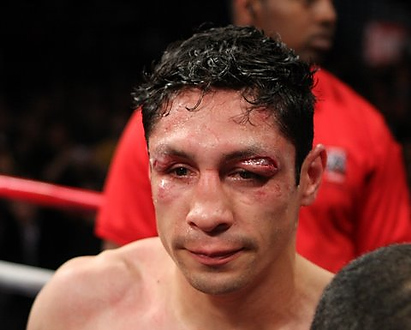
Now that sufficient time has passed since his retirement that we can accurately evaluate Israel Vazquez’s entire career, one thing is certain: Vazquez wore the term “warrior” like a well-fitted suit. A potent punch and an unrelenting resolve crossed paths to produce a gruff pugilist who didn’t like taking “No” for an answer. It took some years for him to earn the respect of mainstream pundits, but once he’d arrived, sending him packing would take something extraordinary. Vazquez fought through hand injuries, swelling and minor cuts before running into Rafael Marquez, but their first three classic bouts upped the ante with a broken nose, slashed eyebrows and horrifically swollen eyes. Vazquez may have been up 2-1 in the series before meandering into their fourth fight, but even though both men were worn down and sucked years of life off the other, Vazquez had undergone multiple scar repair surgeries and a few for a torn retina, and he seemed to have lost some pep in his step against Angel Priolo in what was supposed to have been a tune-up for Marquez-Vazquez IV. Vazquez had already put on his boxing commentating shoes for Spanish language channels, indicating that he was on his way out of the game, but having to perform a blood sacrifice against the same man three times without getting paid like they’d given fans one of the best trilogies in recent memory may have stung. Rumors that Vazquez was forced to wear a face mask during pre-fight sparring flew this way and that, and, true or not, it was only moments into the fight that his left eyebrow split wide open, blocking his vision. A nearly defenseless Vazquez absorbed shots before tasting canvas in the 3rd round, and was cut once more over his right eye and on the edge of going down again in the same round when the action was halted in favor of Marquez. Afterward, Vazquez was encouraged to retire, and to date the fourth Marquez bout remains his last.
(Photo credits: AP Images; Getty Images; Cleva Media; Fightwire Images; Edward Lea/The Press of Atlantic City; Top Rank; Zanfer; Press Association; Osvaldo/Roberto Salas; Allsport; Donald Miralle; Jose Perez Cabrera; Joe Miranda/FightNews.com)

